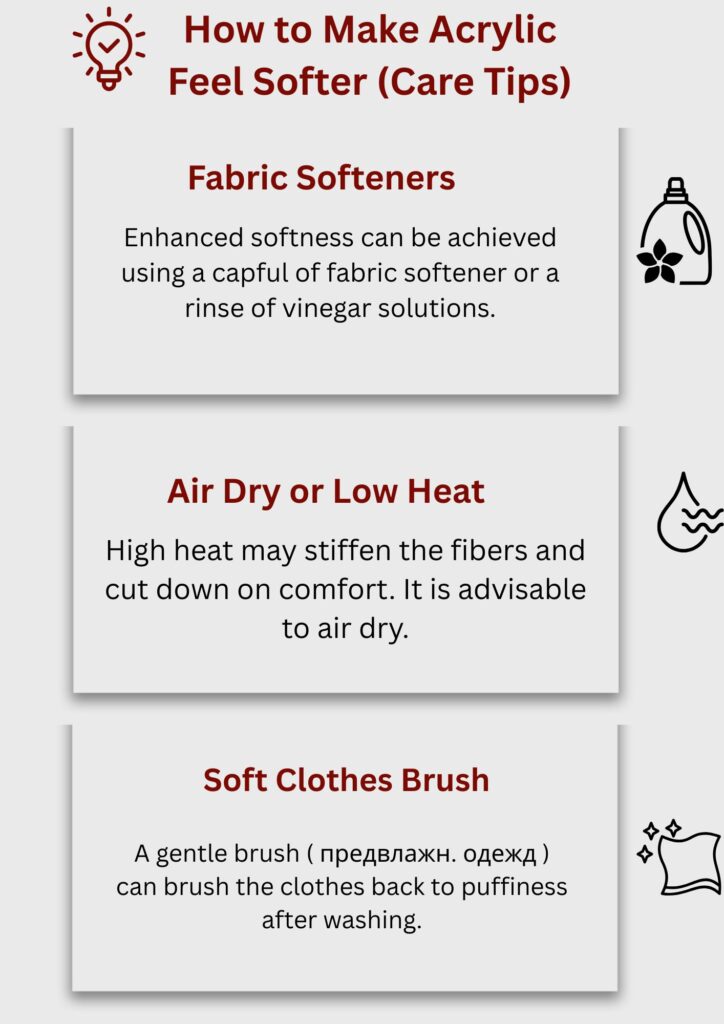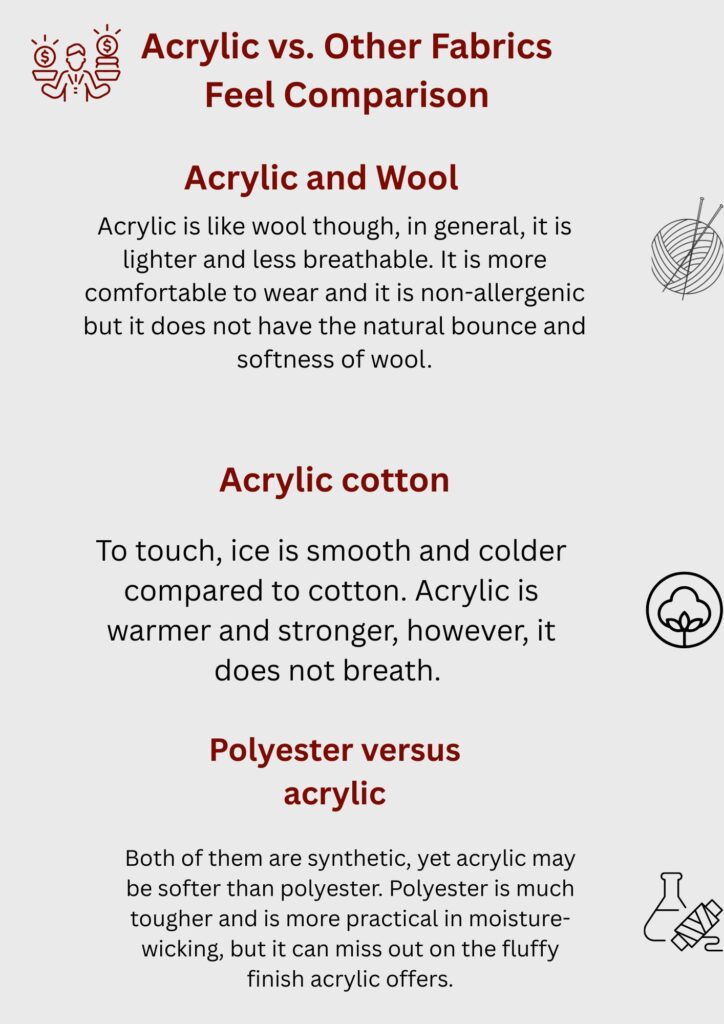Introduction
Acrylic fabric is an artificial fabric produce so as to resemble natural materials such as wool. This fabric is artificial and was launched in the middle of the XX century, it is composed mainly of acrylonitrile, a derivative that is produced through petroleum. Because of this, acrylic has certain performance benefits including durability, warmth and resistance to wrinkles as well as moths.
It is usually turned into knitwear yarn that can be used in making sweaters, hats, scarves, blankets and even upholstery. It consequently finds common use among manufacturing entities as an alternative material, especially when it comes to wool and other natural wrappings that would otherwise be too expensive. There is a variety of texture and feel of the material that produces acrylic fabric even though it is an affordable alternative.
The acrylic material has extensive application in the textile sector because it can be made to resemble costly natural materials. It is hard to deny that it appears everywhere, be it fashion or home furnishings. So what really is the feel of an acrylic fabric? Ok, let us get into the depth of the feel and texture of this special synthetic material.
How Does Acrylic Fabric Feel?
A normal acrylic fabric tends to be light, warm and soft and often feels like wool. Its design gives it the capability of giving a warm feeling particularly when it is chilly. But in low quality acrylics, sometimes the acrylic can feel a little scratchy, or plastic-like. The texture might be different based on the weave as well as processing.
As compared to natural fibers such as cotton and wool, acrylic was less warm but less breathable compared to cotton, and warmer compared to wool fibres. Whereas cotton is cool to touch, acrylic tends to keep warmth and thus the clothing is suitable during winter. It is also lighter than wool and this makes it even comfortable.
Compared to other man made fibres like polyester and nylon, acrylic can be fluffy and soft. Polyester can be slippery or plastic-like and nylon tends to be smooth and a bit elastic.
Texture & Comfort Level
Is It Smooth or Rough?
Depending on the method of manufacturing, acrylic material may be smooth or a little rugged. There are brushed ones that look like cashmere and there are those that tend to have that wooly or textured finish. The touch is very expandable and can be actually developed to be used in this or that way.
Most acrylic materials are designed to imitate the natural softness but the less expensive types can be rough. The finishing and spinning methods during manufacturing process determines whether the material will feel very tender or coarse to your skin.
Is It Stiff or Flexible?
An acrylic is usually soft, though its rigidity may differ. High-quality acrylic fabric flows and hangs well, and so this is appropriate material in fashion clothing. Nevertheless, after being over-processed or being subjected to heat, it can turn out to be firm or hardened.
The other issue is breathability. Acrylic is not as flexible as natural fibers (such as cotton or linen); it cannot provide such a ventilation effect. This may put it in the imperviousness in hot climates even when it has a light weight.
How Does It Feel Against Sensitive Skin?
Acrylic may be an uncomfortable choice to delicate-skinned people. It is indicated as itchy by some users, and more likely with a low-grade material. But blends containing natural fibres or end acrylics are likely to minimize this effect.
In case you are irritable, then you are advised to patch test some small area of acrylic with your skin. Another option is to search blended acrylics with bamboo, cotton or modal so they would be softer and less prone to irritation.
How Does It Feel Against Sensitive Skin?
Sensitive skinned people may not suit acrylic fabric. It results in some itchiness according to some users, particularly with low fabric quality. Mixes that contain natural fibers or upscale acrylics are, however, considered to curtail this effect.
In case you usually react irritably, you should apply a patch of acrylic on the skin. You may also seek blended acrylics with the addition of bamboo, cotton or modal to add softness to it to remove any irritation.
The sense of Acrylic Fabric in Various Products
Sweaters & Scarves
Even acrylic fabric is light, warm and at least a bit soft in sweaters and scarves. The garments sometimes are warmer and are warm in winter. But they can pill with time hence they can change in terms of their texture.
Pilling is indicated as a breakdown of fibers to create tiny balls on the surface. This does not affect warmth and can produce a fabric that is not as smooth. They can be maintained through regular maintenance and cutters with the help of fabric shavers.
Blankets & Throws
Acrylic blankets and throws are cozy and insulating thus they are perfect in cold evenings. Their softness and fluffiness are very warm. They are however likely to trap much heat compared to cotton or bamboo products.
They can be used a lot in winter but they can be too warm in moderate conditions. The absence of breathability can be described as the shared drawback of the jacket and can be dealt with through the appropriate layering.
Upholstery & Rugs
Acrylic is scratchy but feels sturdy in upholstery and rugs. This texture might not have a natural soft aspect like of wool or cotton. Nevertheless, it takes a strong stand in busy locations because it is stronger and not easily affected by fading.
The objects are typically subjected to a closer weave which makes them stiffer and less pliable. Acrylic upholstery is more economical than natural ones, although it is not as fancy.
Pros & Cons of Acrylic Fabric Feel
Pros
- Light and Warmth: Ideal to be used on cold-weather apparel.
- Hypoallergenic on Some: It is not composed of lanolin (which becomes irritating on the sensitive skin).
- Cheap: It is cheap and has a wool feel to it.
Looks and Feels Like Natural Fabrics: Has the ability to emulate wool, cashmere or even cotton feel.
Cons
- Can be Plastic to the Touch: The lower grades may be plastic to the touch.
- Less breathable: Is able to trap heat and moisture.
- Static-Prone: More prone to generating a static charge.
- Not Skin-Friendly At All Times: This skin irritates sensitive skin in certain situations.
How to Make Acrylic Feel Softer (Care Tips)
Acrylic fabric can be greatly helped by proper care in order to enhance its feel. The following are the effective tips:

- Wash in Cold Water: The gentler the cycle the less fiber damage.
- Fabric Softeners: Enhanced softness can be achieved using a capful of fabric softener or a rinse of vinegar solutions.
- Air Dry or Low Heat: High heat may stiffen the fibers and cut down on comfort. It is advisable to air dry.
- Soft Clothes Brush: A gentle brush ( предвлажн. одежд ) can brush the clothes back to puffiness after washing.
- Not Overwashing: Frequent wash deteriorates the fibers and makes them less soft.
It assists in keeping the original texture of acrylic and avoiding stiffness, coarseness with time.
Acrylic vs. Other Fabrics Feel Comparison

Acrylic and Wool
It is more comfortable to wear and it is non-allergenic but it does not have the natural bounce and softness of wool.
Acrylic cotton
To touch, ice is smooth and colder compared to cotton. Acrylic is warmer and stronger, however, it does not breath. Cotton is better in the summer wear.
Polyester versus acrylic
Both of them are synthetic, yet acrylic may be softer than polyester. Polyester is much tougher and is more practical in moisture-wicking, but it can miss out on the fluffy finish acrylic offers.
Each of these fabrics has its particular uses and which one you should pick out depends on what it is you prize the most, softness, breathability or warmth.
Common Misconceptions About Acrylic’s Feel
Most individuals tend to believe that acrylic is always cheap. That is not usually the case. The top acrylic fabrics may be soft, fluffy and extremely comfy. They are of good quality based on the kind of spinning process and the quality of yarn.
The other myth being that acrylic is same as polyester. The difference is that though they are both synthetic they have different textures. Acrylic can be brushed to be soft and polyester tends to be smoother and cool to feel.
Others also think that acrylic is always itchy. It may occur when using low quality acrylics, however, good versions or a mixture is surprisingly soft.
Who Might Like or Dislike Acrylic Fabric?
Acrylic fabric is very attractive to very many consumers and not all consumers as well.
Best For:
- Budget Shoppers: Inexpensive versions of wool or cashmere.
- Cold Weather Wearers: amazing winter clothing insulation.
- Vegan user/Allergy sensitive: No animal fiber, lanolin.
Worst For:
- Individuals having Sensitive Skin: Can be itchy or abrasive.
- Fiber fanatics: Does not breathe in the same way that cotton and linen does.
- Warm Climate Users: It traps heat, so it is not comfortable during summer seasons.
The selection of the right fabric almost always depends on the comfort of a person and their needs regarding the ambiance.
Conclusion
Well, how does acrylic fabric feel like? Usually, it is soft, warm, very light, and wool-like. But it may be comfortable or uncomfortable, depending on quality, weave and use. Whether you are looking at fluffy blankets or cool sweaters, acrylic is suitable and low-cost, yet not the most ideal to wear in the warm weather or on sensitive skin.
Knowing how acrylic feels and the degree of texture can guide you in buying the right materials to have in your wardrobe and house. Acrylic fabric can feel soft and warm, and it can hold up to less expensive prices at the same time. Or be a substitute to wool and yet even vegans may wear it, too. Acrylic fabric, you might just need it in life.


